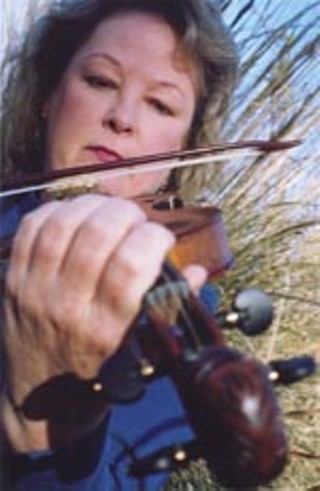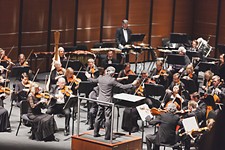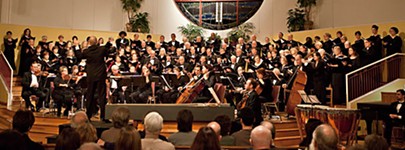The Human Touch
Laurie Young Stevens finds the passion and flash in baroque music
By Robert Faires, Fri., Jan. 16, 2004

You won't catch Laurie Young Stevens bowing to Bach, venerating Vivaldi, or kowtowing to Couperin. Oh, she adores and esteems the music of these great composers as much as any classical musician, but this baroque violinist is no priestess of the concert hall, reverently genuflecting before the marble busts of those musical geniuses and their ilk. To Stevens, these artists aren't stone but flesh, and she can hear the blood pumping through the music that they wrote. When she puts bow to strings for their compositions, she clears away the centuries of awe and deference surrounding them to rediscover the passion and flamboyance, the heated emotion and even garishness, with which these works first lived.
Knowing this may make it easier to understand why Stevens has titled her upcoming concert for the Texas Early Music Project Flash and Trash. "So often we approach Bach with a reverential attitude," she says. "We're afraid to make it as flashy as it can be. But this Bach sonata that I'm playing [on the program] is so expressive and fleshy and virtuosic" that she is inspired to find the flash.
And she doesn't stop with Johann Sebastian. The same goes for Handel, Vivaldi, Schutz, and Couperin, all of whom have work on the program. "A lot of people think of this music as calm and sedate," she says, "but there is a lot of drama and contrast in these pieces." And with help from harpsichordist Keith Womer, lutenist Scott Horton, and tenor David Stevens -- who also happens to be the violinist's hubby -- she aims to make our ears ring with them.
You can count on Stevens to succeed. A two-time Austin Critics Table Award nominee for "Outstanding Instrumentalist," she knows her baroque music, as can be measured by her 10 years as concertmistress for TEMP, an organization that takes early music seriously and has the national rep to show for it. A leading reason is founder and Artistic Director Daniel Johnson, a scholar, teacher, and musician whose work in the field has taken him across the globe and won acclaim and awards. Praise from him carries weight, and he has lots of praise for Stevens. Of her musicianship, he says, "Laurie is very creative in the way she shapes a line. She infuses it with ornamentation that is inherent in the line itself. It isn't just glitter. There's a subtlety that she has that she isn't afraid to use. And she has a beautiful, beautiful tone -- all the great things that a violinist is supposed to have."
Johnson also appreciates Stevens' warm-blooded treatment of those deified composers in the Classical Music Hall of Fame. "These are people that we all have been taught to revere as the gods of baroque music, and she's finding the more human approach to them, the fun approach, and bringing them to us as parts of music rather than unapproachable icons."
Johnson probably knows Stevens' skills as well as anyone. It was Johnson who gave Stevens her introduction to baroque music. In 1987, after she and her husband David had been living in Austin for a few years, she approached Johnson, who was then leading the Early Music Ensemble at the UT School of Music, about teaching her baroque music. He taught her the rudiments of ornamentation -- the slides, trills, turns, and other musical embellishments that flavor the compositions of that era -- by whistling ornaments to her.
According to Johnson, she latched onto it very quickly and just as quickly launched herself into serious study of the period and style. She studied with Manfred Kraemer, Elizabeth Blumenstock, Phoebe Carrai, and others -- "some of the true greats in period instruments," as Stevens describes them. It was a rebirth for her artistically, a totally new approach to music she had learned to play in a mainstream way. Now, 16 years after she went to Johnson, local musicians are coming to her to help them shape their performance of that period's music.
It may seem a far cry from her youth in Abilene, where Stevens lived from second grade through college. In those days, she was part of her father's country & western swing band, playing fiddle at Saturday night dances in VFW and Legion halls sprinkled across the Panhandle. But Stevens herself doesn't see it that way. The music is so similar to her ear in its setup of chord and harmonic structure, and the room it leaves the musicians for a lot of improvisation. Not to mention that playing for people who "are dancing four feet away" develops a player's keen sense of relationship to the audience that serves a musician well when playing chamber music.
Not that Stevens' life in Abilene was devoid of classical music. There was a local symphony, and owing to the limited number of skilled players in the region, she was able to play with the orchestra full time during high school. As a result, by the time she left her hometown, she was not only familiar with most of the basic symphonic literature, she had played it herself -- an experience she'd have been unlikely to have gotten in a larger community.
These days, Stevens stays busy. Very busy. This weekend, she has the TEMP Flash and Trash concert. The weekend of Valentine's Day, as part of the Austin Bach Quartet, she'll play Le Muse Giocose (The Playful Muses), a concert of early Italian baroque music featuring soprano Jenifer Thyssen. The week after, she'll join La Follia for Tour de France, a concert of music composed for the court of Versailles and the cathedral of Notre Dame. The week after that is another TEMP concert, Three Worlds of Spain: Islam, Christian and Judaic, featuring Spanish dances and love songs from the 14th to the 17th century. Then there are weddings to play nearly every week. ("The bread-and-butter of a string player's existence is gigging," she says.)
And if she isn't performing around Austin, chances are Stevens is playing somewhere else; she's played with the Texas Bach Choir, Ars Lyrica Houston, Texas Bach Collegium, Chanticleer Sinfonia, Seattle Baroque Orchestra, and Philharmonia Baroque Orchestra of San Francisco. Stevens' work with this last ensemble has been most gratifying. "Each time I go out there is like a big two-week lesson," she says. By asking players for their input and encouraging them to build on what's on the page, conductor Nicholas McGegan builds a sense of ensemble and a feeling of musicians being comfortable with the music and one another.
Johnson sees Stevens bringing those qualities back to Austin. When she's working with players, Johnson notes, "she knows how to say what she needs to say without being authoritarian." He credits her with nurturing players (skills honed from years of practice with her children Andrew, Alex, and Alyssa). Stevens says that it's all about keeping the environment safe, so that everyone feels that it's OK to try new things and make mistakes, even to fall flat on your face. If that happens, she'll gently suggest a different approach or maybe make a joke -- she's known for her sense of humor -- but whatever she does, it will have the human touch. With Stevens, that's the constant.
Johnson recalls a duet that Stevens played with a faculty member from Baylor years ago. The music was difficult, and the two had gotten to rehearse it only once, but as they were playing, during what Johnson calls "all this furious imitation and nonstop activity," something magical happened. Stevens started an imitation that the other musician had to follow, and something rich and human rang out from her violin. Soprano Stephanie Prewitt, who was sitting with Johnson, turned to him and just went, "Oh." Such reactions weren't caused by something in the score, he notes. "That was Laurie. With her, they happen all the time." ![]()
Flash and Trash will be presented Saturday Jan. 17, 8pm, at First English Lutheran Church, 3001 Whitis. For tickets, call 474-TIXS; for more information, call 371-0099 or visit www.early-music.org.










